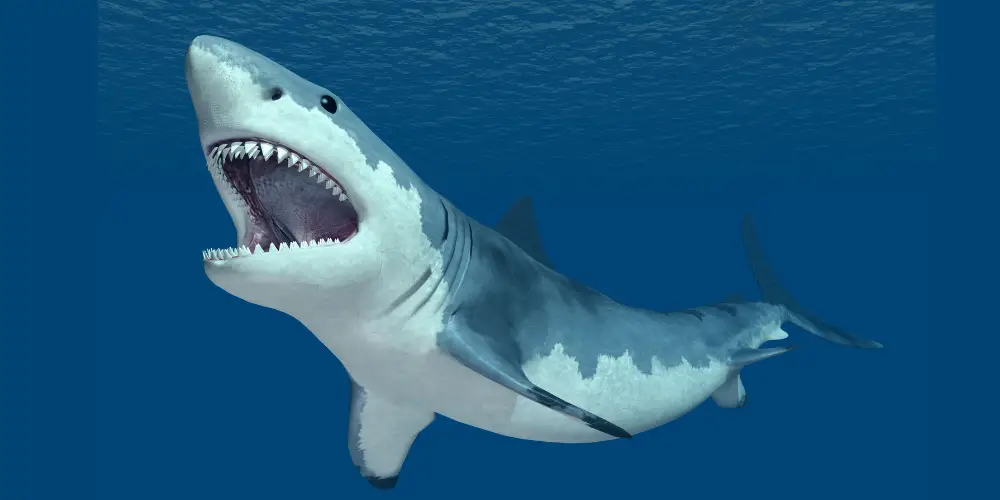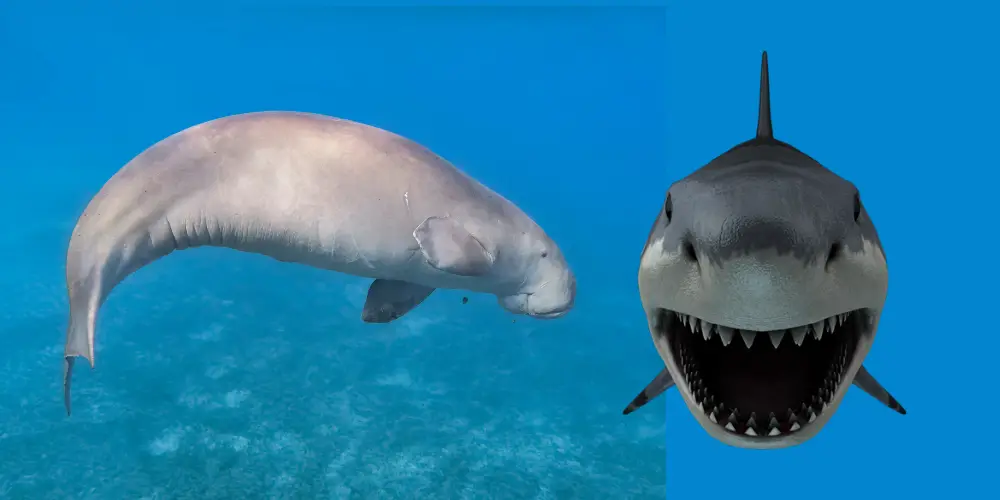Have you ever wondered about the anatomy of a shark? These magnificent creatures of the deep have fascinated humans for centuries.
One question that often arises is, “Do sharks have tongues?” It’s a curious inquiry, considering how integral tongues are to many animals, especially regarding feeding.
Sharks have tongues, but they’re not like those in mammals. A shark’s tongue, known as a “basihyal,” is a small, thick piece of cartilage located on the floor of the mouth, which cannot move freely like our tongues.
In humans and most other animals, the tongue is a muscular organ that plays a significant role in eating, swallowing, and speaking.
However, in sharks, the basihyal doesn’t play a role in feeding because it’s not flexible. Instead, sharks rely on their teeth and strong jaw to catch and eat their prey.
In this article, we will dive deep into the world of sharks and uncover the truth about their tongues.
Shark Tongue Anatomy
Regarding the anatomy of a shark’s tongue, things are quite different compared to humans and many other animals.
What appears to be a tongue in a shark’s mouth is not in the traditional sense.
Basihyal
The structure that resembles a tongue in a shark’s mouth is known as the basihyal.
This is a small, thick piece of cartilage located on the floor of the shark’s mouth. Unlike a human tongue, the basihyal is not flexible and does not move freely.
It is attached to the shark’s mouth and cannot be extended out of the mouth like a human or many other animals can with tongues.
Function
The basihyal does not affect the shark’s feeding process. Sharks do not use it to taste or manipulate food.
Instead, sharks rely on their teeth and strong jaw to capture and consume their prey. The taste buds in a shark’s mouth and throat are responsible for tasting food.
Comparison with Other Fish
In many bony fish, the basihyal is part of a complex structure known as the tongue, which can move and is often used to manipulate food.
However, the basihyal is much simpler in sharks, which are cartilaginous fish, and does not have these functions.
Understanding the anatomy of a shark’s “tongue” helps to dispel some common misconceptions and provides insight into the unique adaptations of these incredible marine creatures.
Myths About Sharks Tongues
Sharks are often the subject of myths and misconceptions; their tongues are no exception. Here, we’ll debunk some of the most common myths about shark tongues and provide the facts.
Myth 1: Sharks Use Their Tongues to Taste Their Food
One common misconception is that sharks use their tongues to taste their food. This belief likely stems from the way many animals, including humans, use their tongues for tasting. However, this is not the case for sharks.
In reality, sharks use their taste buds to discern the flavor of their food, much like humans do.
However, these taste buds are not located on the basihyal, the structure often mistaken for a tongue. Instead, they are found inside the shark’s mouth and throat.
When a shark bites its prey, it uses these taste buds to determine whether or not to proceed with eating. If the taste is not to the shark’s liking, it will often release its prey.
Myth 2: Sharks Can Stick Out Their Tongues
Another common myth is that sharks can stick out their tongues like humans or other animals.
This misconception may come from images or videos showing a shark with its mouth open, where the basihyal is visible and could be mistaken for a protruding tongue.
However, the truth is that sharks cannot stick out their tongues.
The basihyal, the structure in a shark’s mouth that resembles a tongue, is a piece of cartilage fixed to the mouth’s floor and cannot move freely. Therefore, unlike many animals, sharks cannot stick out their tongues.
Myth 3: Sharks Have a Tongue Like Other Fish
Some people might think that sharks, being fish, have a tongue similar to other fish. However, this is not true.
Most fish have a structure called a bony tongue. Unlike the basihyal in sharks, this structure can move and is used to manipulate food. Sharks, on the other hand, do not have this ability.
Understanding these misconceptions helps us appreciate the unique and fascinating nature of sharks.
They are creatures perfectly adapted to their environment, and every aspect of their anatomy, including their lack of a true tongue, plays a crucial role in their survival.
How Sharks Eat Without a Tongue
Sharks have a unique and efficient way of eating that doesn’t require tongue use. Their feeding process is a marvel of evolution, perfectly adapted to the aquatic environment in which they live. Here’s how it works:
Spotting the Prey
When a shark spots its prey and is ready to feed, it will open its mouth. As it does so, water flows in along with the prey.
Breathing While Eating
This might seem like a problem – after all, sharks need to breathe, and they do so by forcing water through their gills, where oxygen is extracted.
However, sharks have evolved a clever solution. After the shark closes its mouth, it expels the water through its gills, effectively breathing while its mouth is closed. The prey, meanwhile, is trapped inside to be eaten.
Using Their Teeth
Sharks rely heavily on their teeth for feeding. They have multiple rows of sharp, serrated teeth that are perfect for tearing into the flesh of their prey.
These teeth are not just for show – they are one of the shark’s primary tools for hunting. Some sharks, like the great white shark, can even have up to 300 teeth at a time!
These teeth are continually replaced throughout the shark’s life, ensuring they always have a sharp set ready for their next meal.
The Role of the Jaw
A shark’s jaw is also crucial to its feeding process. Unlike human jaws, which move up and down, a shark’s jaw can move up and down, forward and backward.
This unique adaptation allows the shark to reach out and grab its prey, then pull it into its mouth.
This powerful jaw, combined with their sharp teeth, makes sharks incredibly effective predators.
Swallowing the Food
Sharks also have a unique food-swallowing method. Instead of using a tongue to help push food down their throat as humans do, sharks use their strong muscles and gravity to swallow their prey whole or in large chunks.
To learn more about the unique features of sharks, check out our article Do Sharks Have Eyelids?
This article delves into another fascinating aspect of shark anatomy, demonstrating how these incredible creatures are perfectly adapted to their oceanic environment.
Other Unique Features of Sharks Related to Feeding
Sharks are fascinating creatures with several unique features that aid in their feeding. These features testify to their evolution and adaptation to the aquatic environment.
Highly Developed Sense of Smell
Many sharks have a highly developed sense of smell, which they use to locate their prey.
Sharks have two nostrils (or nares) on their snout’s underside. Water flows through these nostrils, carrying the scent of potential prey.
Some sharks can even detect a single drop of blood in a million drops of water! This keen sense of smell allows sharks to locate prey from a considerable distance, making them efficient hunters in the vast ocean.
Lateral Line System
Another interesting feature is the lateral line system, a network of fluid-filled canals located along the sides of a shark’s body.
This system is a set of motion detectors that can sense the slightest movement and vibrations in the water.
When other animals swim, they create waves that the lateral line system can detect, helping sharks to locate their prey and navigate their surroundings.
This system also allows sharks to detect approaching predators or other threats, making it a crucial part of their survival strategy.
Ampullae of Lorenzini
Sharks also have a special organ called the ampullae of Lorenzini. These are small, jelly-filled sacs located around the shark’s snout.
These sacs can detect the electric fields other animals produce in the water. Every animal produces a small amount of electricity through their muscle contractions and heartbeats.
Sharks can sense these electric fields, helping them find prey hiding in the sand or other hiding places.
This ability to detect electric fields is so precise that sharks can even determine the shape and size of the prey.
Specialized Teeth and Jaw
In addition to these features, it’s worth noting again the role of the shark’s teeth and jaw in feeding.
Depending on the species, sharks have different teeth ranging from sharp, pointed teeth for grabbing small, slippery prey to serrated teeth for tearing the flesh of larger prey.
Their powerful jaws can exert tremendous pressure, allowing them to bite through tough materials.
Curious about what sharks eat?
Check out our article Do Sharks Eat Manatees? This article explores the diet of sharks, providing insight into their feeding habits and preferences.
Frequently Asked Questions
1. How Many Tongues Does a Shark Have?
Sharks do not have a tongue like humans or most other animals do. What appears to be a tongue in a shark’s mouth, a small piece of cartilage known as a basihyal, which cannot move freely.
2. Do Great White Sharks Have a Tongue?
Like all sharks, great white sharks have a basihyal, a piece of cartilage resembling a tongue. However, it is not a true tongue as it is not flexible and does not assist in feeding or tasting.
3. What Animals Do Not Have Tongues?
Several animals do not have tongues, including sea urchins, starfish, and other echinoderms. Additionally, some birds, like flamingos, have a bill instead of a traditional tongue.
Conclusion
Sharks are fascinating creatures with unique anatomical features that set them apart from other marine animals.
Contrary to popular belief, sharks do not have tongues like humans and many other animals.
Instead, they have a small piece of cartilage known as the basihyal that sits on the floor of their mouth.
This structure cannot move freely and is not used for tasting or manipulating food.
Sharks have evolved to have highly efficient feeding mechanisms that do not require the use of a tongue.
They rely heavily on their sharp, serrated teeth and powerful jaws to capture and consume their prey.
Additionally, sharks have a range of other specialized features that aid in feeding, such as a highly developed sense of smell, a lateral line system for detecting movements and vibrations in the water, and the ampullae of Lorenzini for sensing electric fields.
Understanding sharks’ anatomy and feeding habits can help us appreciate these incredible creatures and their important role in our oceans.
It also highlights the need for ongoing research and conservation efforts to protect sharks and their habitats.
Still curious about sharks?
READ THESE ARTICLES:
REFERENCES:
- Shark. (2023, June 3). In Wikipedia. https://en.wikipedia.org/wiki/Shark
- Florida Museum. (n.d.). Great White Shark | Florida Museum of Natural History. Retrieved June 5, 2023, from https://www.floridamuseum.ufl.edu/discover-fish/species-profiles/carcharodon-carcharias/
- Shark Sider. (n.d.). Shark Senses | Shark Sider. Retrieved June 5, 2023, from https://www.sharksider.com/shark-senses/




